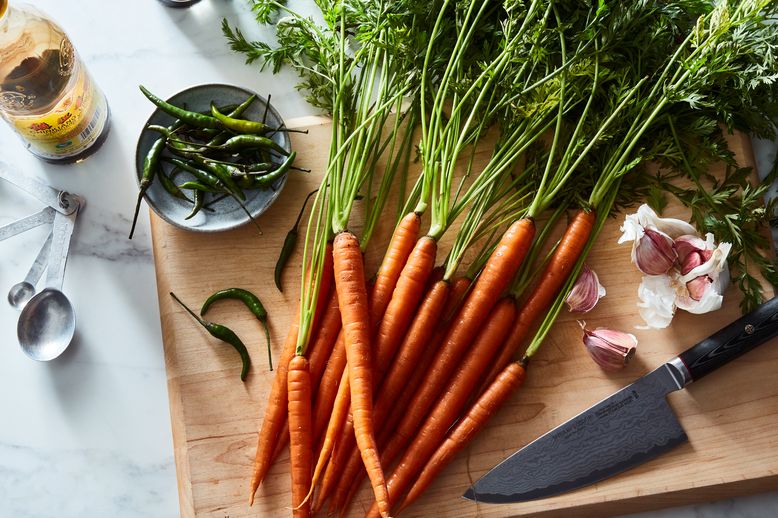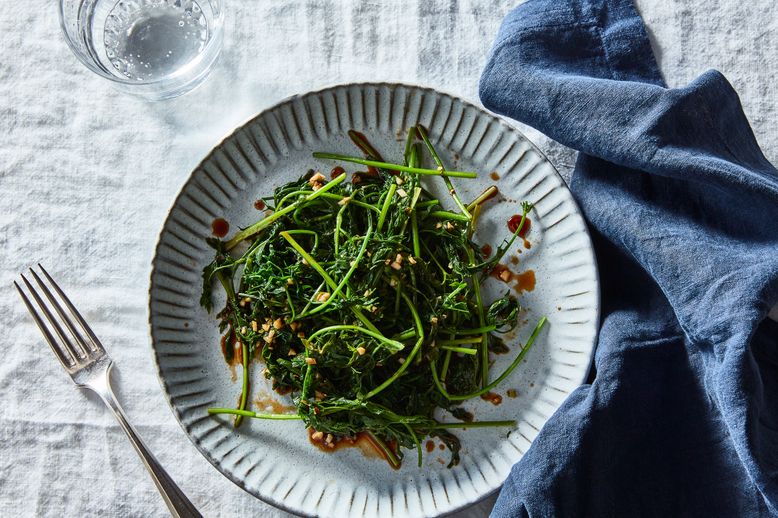This post originally appeared in Genius Recipes on Food52.
I make the same damn salad every night. Even though I’ve gathered many far more delicious and interesting ones over the years, night after night I toss together arugula, lemon, olive oil, and salt with one hand and claw it onto our plates — only because it fills the green gap in any dinner, and I don’t have to fire up a single extra brain cell.
Given my requirements, it took this forcefully simple green salad to shove me out of my workday rut. And even though the recipe comes from the other side of the world, I’ve found it fits just as neatly into my routine as my snoozy pile of arugula.
As Georgia Freedman was gathering recipes and stories in the Yunnan province of China for her recent cookbook Cooking South of the Clouds, she encountered many salads in this style, but learned this particularly gripping one from Tusheng Shiguan (Native Foods) restaurant, founded by Yang Lifen to support the farmers surrounding Kunming, the province’s capital city. The resulting recipe solves at least two major salad problems, and takes precious little effort to get there.
The first major salad problem (MSP1) is the sad lettuce impasse — when you get to the market and every last head of red leaf and sack of spinach is looking limp and uninspiring. At Tusheng Shiguan, the kitchen uses a rotating cast of locally foraged greens, including one that’s a close cousin of the carrot (without the sweet, carrot-y root) — so Freedman adapted the recipe to work with the bushy carrot tops that so many of us throw away. (No, despite what you may have heard, the greens are not poisonous.)
All you have to do to take carrot tops from unruly to proper salad is to give them a blanch — aka a dunk in boiling water, rinse, squeeze, and chop. This trick also works well with other hardier leafy greens, or other cold, cooked vegetables, tofu, or meats in the genre of salads known as liang ban. With decent lettuce no longer a prerequisite, this breaks our green salad options on any old night wide open. MSP1, overcome.

Food52 / / James Ransom
The second major salad problem (MSP2) is our desire to make a balanced, just-right vinaigrette — fast — that will inspire us to eat heaps of otherwise plain vegetables. You might have your favorite ratio of vinegar to oil (and I have my lemon), but this dressing offers another, more exciting path.
It’s just four ingredients, with far more personality than straight oil and acid: the funky-sweet pow of black vinegar, the salty umami of soy sauce, the heat of garlic and fresh chile. Though this style of salad is common across China, the garlicky, tangy dressing specific to this region is Freedman’s favorite. I can see why — once it burrows into the cooling, parsley-like flavor of the greens, you could easily eat a whole bushel.
For the best moments to serve this salad, Freedman recommends richer meals that need a bright pick-me-up, in a similar spirit to the vinegary slaws that lift up the weight of barbecue. She mentioned roast chicken and, from one memorable visit to a local ham-maker in Eastern Yunnan, stir-fried ham with fried potatoes and garlic chives. But I’d also recommend it any time you’re resenting your own every-night salad and ready to make the break.
Here it is — Georgia Freedman & Tusheng Shiguan’s Carrot Greens Salad
Makes: 1 1/2 to 2 cups
Prep time: 15 min
Cook time: 2 min
Ingredients
- 6 cups packed (1 pound) carrot greens
- 5 teaspoons Shaanxi vinegar (or substitute Chinkiang black vinegar — see note)
- 4 teaspoons light soy sauce (see note)
- 1 tablespoon minced garlic
- 1/2 teaspoon minced fresh Thai chiles
Directions
- Bring a pot of water to a boil and blanch the greens until the thick parts of the stems are tender and pliable, 1 to 2 minutes. Drain the greens, rinse them with water until cool, then squeeze out all the excess water. Cut the greens into 1 ½ to 2-inch-long pieces (you will have 1 ½ to 2 cups of greens).
- Transfer the greens to a small mixing bowl. Just before serving, add the remaining ingredients and mix well. Taste and add more vinegar or soy sauce if needed, then transfer to a serving plate.
Notes: Chinkiang (Zhenjiang) can be easier to find but more bright and tart than Shaanxi — when substituting, start with about 1/2 to 3/4 of the amount, and adjust to taste. Follow the same principle if you need to substitute darker or heavier sodium styles of soy sauce or a milder green.



